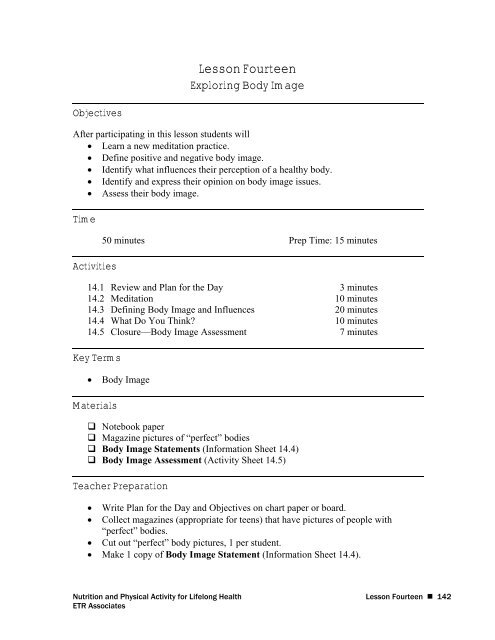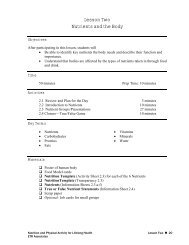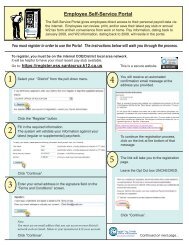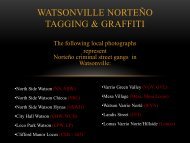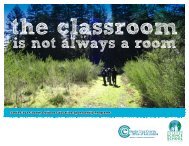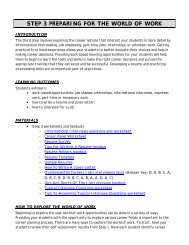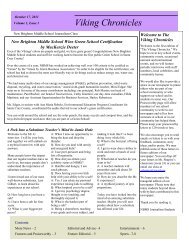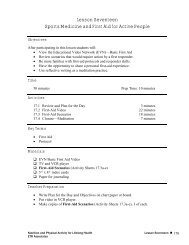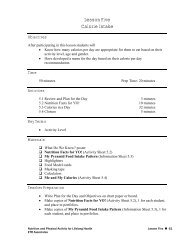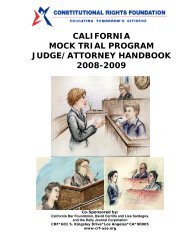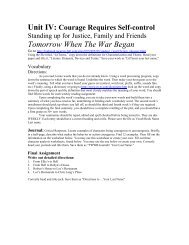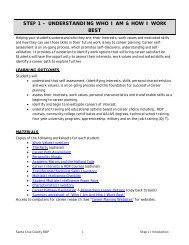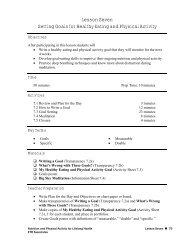Lesson Fourteen - Physical Education for Body, Mind and Spirit
Lesson Fourteen - Physical Education for Body, Mind and Spirit
Lesson Fourteen - Physical Education for Body, Mind and Spirit
Create successful ePaper yourself
Turn your PDF publications into a flip-book with our unique Google optimized e-Paper software.
<strong>Lesson</strong> <strong>Fourteen</strong><br />
Exploring <strong>Body</strong> Image<br />
Objectives<br />
After participating in this lesson students will<br />
• Learn a new meditation practice.<br />
• Define positive <strong>and</strong> negative body image.<br />
• Identify what influences their perception of a healthy body.<br />
• Identify <strong>and</strong> express their opinion on body image issues.<br />
• Assess their body image.<br />
Time<br />
Activities<br />
50 minutes Prep Time: 15 minutes<br />
14.1 Review <strong>and</strong> Plan <strong>for</strong> the Day 3 minutes<br />
14.2 Meditation 10 minutes<br />
14.3 Defining <strong>Body</strong> Image <strong>and</strong> Influences 20 minutes<br />
14.4 What Do You Think 10 minutes<br />
14.5 Closure—<strong>Body</strong> Image Assessment 7 minutes<br />
Key Terms<br />
• <strong>Body</strong> Image<br />
Materials<br />
Notebook paper<br />
Magazine pictures of “perfect” bodies<br />
<strong>Body</strong> Image Statements (In<strong>for</strong>mation Sheet 14.4)<br />
<strong>Body</strong> Image Assessment (Activity Sheet 14.5)<br />
Teacher Preparation<br />
• Write Plan <strong>for</strong> the Day <strong>and</strong> Objectives on chart paper or board.<br />
• Collect magazines (appropriate <strong>for</strong> teens) that have pictures of people with<br />
“perfect” bodies.<br />
• Cut out “perfect” body pictures, 1 per student.<br />
• Make 1 copy of <strong>Body</strong> Image Statement (In<strong>for</strong>mation Sheet 14.4).<br />
Nutrition <strong>and</strong> <strong>Physical</strong> Activity <strong>for</strong> Lifelong Health <strong>Lesson</strong> <strong>Fourteen</strong> • 142<br />
ETR Associates
• Prepare chart paper with body image questions. (See Activity 14.4.)<br />
• Make copies of <strong>Body</strong> Image Assessment (Activity Sheet 14.5), 1 <strong>for</strong> each<br />
student, <strong>and</strong> place in portfolios.<br />
14.1 Review <strong>and</strong> Plan <strong>for</strong> the Day 3 minutes<br />
Materials: Plan <strong>for</strong> the Day <strong>and</strong> Objectives<br />
Write the Plan <strong>for</strong> the Day <strong>and</strong> Objectives on the board be<strong>for</strong>e class, listing all of the<br />
activities students will be doing.<br />
Plan <strong>for</strong> the Day:<br />
• Meditation<br />
• Defining <strong>Body</strong> Image <strong>and</strong> Influences<br />
• What Do You Think<br />
• Closure—<strong>Body</strong> Image Assessment<br />
Review the previous class. What do students remember from watching the movie Super<br />
Size Me<br />
Explain that today they will be learning about body image issues <strong>and</strong> will be doing some<br />
different activities related to this subject.<br />
Review the Objectives with students.<br />
14.2 Meditation 10 minutes<br />
Materials: Notebook paper <strong>for</strong> students to free write on.<br />
Explain that today’s meditation practice will involve writing.<br />
• Introduce the concept of reflective journaling as a way of meditating on an issue.<br />
• Tell students to find a place in the room where they will not be distracted by<br />
others.<br />
• Explain that in doing this <strong>for</strong> the first time, they can write on any topic they<br />
choose. The important thing is that they continue to write. When they feel they<br />
have nothing to write about, tell them to write, “I don’t know what to write.”<br />
Eventually something will come to them.<br />
• Explain that no one will be reading this. This practice is personal <strong>and</strong> can be<br />
helpful in resolving a problem or issue they may be having.<br />
Nutrition <strong>and</strong> <strong>Physical</strong> Activity <strong>for</strong> Lifelong Health <strong>Lesson</strong> <strong>Fourteen</strong> • 143<br />
ETR Associates
• Have students free write <strong>for</strong> about 6 minutes.<br />
• Once the students have finished writing, have them come back to their seats <strong>and</strong><br />
ask if any of them have used this practice be<strong>for</strong>e as a way to relax or calm<br />
themselves. If no one responds, ask if they think they will try using this practice<br />
<strong>and</strong> what the benefits might be.<br />
14.3 Defining <strong>Body</strong> Image <strong>and</strong> Influences 20 minutes<br />
Materials: Chart paper <strong>and</strong> markers, magazines with pictures of “perfect” bodies<br />
Explain that today students are going to discuss what shapes beliefs about what a body<br />
should look like.<br />
• Ask students: What is “body image” (1. How you see your body, 2. How you<br />
think others see your body, <strong>and</strong> 3. How you feel as a result.)<br />
• Make a list of their responses on chart paper. Be sure to include the above<br />
definition.<br />
• Ask students what “positive body image” is (seeing <strong>and</strong> appreciating your body as<br />
it really is <strong>and</strong> feeling com<strong>for</strong>table <strong>and</strong> confident with your body). Record their<br />
responses.<br />
• Then ask what “negative body image” is (having a distorted perception of body<br />
shape, feeling ashamed <strong>and</strong> self-conscious about your body or feeling<br />
uncom<strong>for</strong>table <strong>and</strong> awkward in your body). Record their responses.<br />
• Ask: What influences our body image What are some things that influence a<br />
person’s idea about what an ideal body should be<br />
• Record students’ responses. If possible, once students have given enough<br />
answers, categorize these ideas under Friends, Family, <strong>and</strong> Society/Media. If<br />
students don’t respond with ideas, begin by writing down some of your own, then<br />
ask them leading questions such as “Does your family influence how you think<br />
about your body”<br />
The intention of the activity is <strong>for</strong> the students to come to an increased awareness of<br />
where their influences come from around body image, including the media. If students<br />
have not already brought up the media, talk about how the media can play a significant<br />
role in our view on body image.<br />
Tell students they are now going to make a list of qualities that make a “perfect” body<br />
based on photographs from magazines.<br />
Nutrition <strong>and</strong> <strong>Physical</strong> Activity <strong>for</strong> Lifelong Health <strong>Lesson</strong> <strong>Fourteen</strong> • 144<br />
ETR Associates
• Pass out magazine pictures of “perfect” bodies, one per student or per pair.<br />
• Have students write down what is “perfect” about the pictured person’s body<br />
(e.g., long legs, smooth skin, big lips, white teeth, flat stomach, etc.).<br />
• Once students have made a list, ask some of them to share what they wrote.<br />
• Discuss whether these media images are a realistic portrayal of a healthy body<br />
image. The intention is <strong>for</strong> students to start to underst<strong>and</strong> that everyone’s body is<br />
different <strong>and</strong> that we all can’t look the same or have the type of body often shown<br />
in magazines. The important message is to eat healthy food <strong>and</strong> exercise to<br />
develop the body that is perfect <strong>for</strong> you.<br />
• Discuss the wide usage of digital enhancement software in modern advertising.<br />
• Help students recognize that as long as they are making healthy food choices <strong>and</strong><br />
being physically active, they are doing what they can to have a healthy body, <strong>and</strong><br />
that every body is different. A person can be totally fit <strong>and</strong> healthy <strong>and</strong> not have<br />
the legs of a model.<br />
14.4 What Do You Think 10 minutes<br />
Materials: <strong>Body</strong> Image Statements (In<strong>for</strong>mation Sheet 14.4), chart paper with body<br />
image questions, notebook paper<br />
Explain that this is an activity where students will be expressing their opinions around<br />
body image issues. They will line up on a continuum (line) based on their opinion about<br />
a statement that will be read to them. Explain that one end of the continuum is “Strongly<br />
Agree” <strong>and</strong> the other end is “Strongly Disagree,” <strong>and</strong> that the less strongly they feel, the<br />
closer they will be to the middle.<br />
• Have students st<strong>and</strong> in the middle of the room <strong>and</strong> then read the first statement.<br />
• Tell students to st<strong>and</strong> somewhere along the continuum, based on their opinion of<br />
the statement.<br />
• Ask <strong>for</strong> volunteers to express why they stood where they did.<br />
• Read 5 of the statements <strong>and</strong> have students st<strong>and</strong> on the continuum <strong>for</strong> each one.<br />
Then have students sit down. Thank them <strong>for</strong> giving their opinions about body<br />
image.<br />
Explain that they are now going to answer some questions on their own, silently. These<br />
questions are focused on how they support positive body image among their friends <strong>and</strong><br />
family. Show them the chart paper with the following questions written on it:<br />
Nutrition <strong>and</strong> <strong>Physical</strong> Activity <strong>for</strong> Lifelong Health <strong>Lesson</strong> <strong>Fourteen</strong> • 145<br />
ETR Associates
• How often do you encourage someone to feel good about his/her body as<br />
it is<br />
• How often do you compliment others on their ideas, actions <strong>and</strong> character<br />
<strong>and</strong> not just on how they look<br />
• How often do you recognize <strong>and</strong> appreciate positive qualities in yourself<br />
other than your looks<br />
• How often do you challenge or voice disapproval of “fat jokes” or<br />
negative comments about being “too fat” or “too skinny,” “ugly,” etc<br />
Remind students that they can be a role model to others <strong>and</strong> that supporting positive body<br />
image is a healthy way to live.<br />
14.5 Closure—<strong>Body</strong> Image Assessment 7 minutes<br />
Materials: <strong>Body</strong> Image Assessment (Activity Sheet 14.5)<br />
Explain that students will now think about how they feel about their bodies by answering<br />
some questions. Reassure them that this in<strong>for</strong>mation is <strong>for</strong> them only—they will not be<br />
sharing it with the class or anyone else.<br />
• Point out the <strong>Body</strong> Image Assessment activity sheet in their portfolios. Explain<br />
that they are to pick 3 of their body parts <strong>and</strong> describe what they like about that<br />
body part.<br />
• Have students complete the activity sheet.<br />
• Then have students share with a partner one thing they intend to do to improve<br />
their body image.<br />
Resources<br />
TRIBES: A New Way of Learning <strong>and</strong> Being Together by Jeanne Gibbs.<br />
Activity 14.3 Defining <strong>Body</strong> Image & Influences: from All4You2! curriculum, <strong>Lesson</strong> 24,<br />
Activity 4.<br />
Activity 14.4 <strong>Body</strong> Image Questions: from All4You2! curriculum, <strong>Lesson</strong> 25, Activity 4.<br />
<strong>Body</strong> Image Assessment from HealthSmart High School, Nutrition & <strong>Physical</strong> Activity<br />
<strong>Lesson</strong> 4, Activity 1.<br />
Nutrition <strong>and</strong> <strong>Physical</strong> Activity <strong>for</strong> Lifelong Health <strong>Lesson</strong> <strong>Fourteen</strong> • 146<br />
ETR Associates
In<strong>for</strong>mation Sheet 14.4<br />
<strong>Body</strong> Image Statements<br />
1. <strong>Body</strong> image relates only to how much you weigh.<br />
2. Most U.S. teenagers have a negative body image.<br />
3. Most teens don’t care about body image.<br />
4. You can have a fit body <strong>and</strong> not look like a supermodel.<br />
5. The media do not influence how we feel about our bodies.<br />
6. How we see our bodies <strong>and</strong> how others see our bodies affects<br />
how we feel about ourselves.<br />
7. Negative body image can lead to people having eating<br />
disorders.<br />
8. The media display all types of bodies in advertisements.<br />
Nutrition <strong>and</strong> <strong>Physical</strong> Activity <strong>for</strong> Lifelong Health <strong>Lesson</strong> <strong>Fourteen</strong> • 147<br />
ETR Associates
Activity Sheet 14.5<br />
<strong>Body</strong> Image Assessment<br />
Directions:<br />
<strong>Body</strong> Parts<br />
Hair<br />
Skin<br />
H<strong>and</strong>s<br />
Nose<br />
Ears<br />
Eyes<br />
Neck<br />
Legs<br />
Teeth<br />
Feet<br />
Posture<br />
Eye lashes<br />
Fingernails<br />
Face<br />
Lips<br />
Muscle tone<br />
Arms<br />
Waist<br />
Shoulders<br />
Choose 3 body parts or attributes from the list. Write a<br />
sentence or two describing what you like about each<br />
one.<br />
<strong>Body</strong> Part: _____________________________________<br />
_______________________________________________<br />
_______________________________________________<br />
_______________________________________________<br />
<strong>Body</strong> Part: _____________________________________<br />
_______________________________________________<br />
_______________________________________________<br />
_______________________________________________<br />
<strong>Body</strong> Part: _____________________________________<br />
_______________________________________________<br />
_______________________________________________<br />
_______________________________________________<br />
Adapted with permission from Health Smart High School.<br />
Nutrition <strong>and</strong> <strong>Physical</strong> Activity <strong>for</strong> Lifelong Health <strong>Lesson</strong> <strong>Fourteen</strong> • 148<br />
ETR Associates


